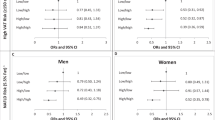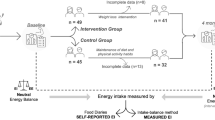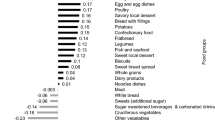Abstract
Background/Objectives:
Previous cohort studies elucidated unexpected inverse relations of cake and cookie (CC) consumption with chronic disease risk. We assessed CC intake in relation to cardiometabolic disease risk factors in a well-phenotyped population with emphasis on misreporting as the potential driving force behind inverse relations.
Subjects/Methods:
In a cross-sectional EPIC-Potsdam sub-study individual usual CC intake was modeled by combining 24 h recall and food frequency questionnaire data. Cardiometabolic risk factors were anthropometry, blood lipids, blood pressure (BP), physical activity and fitness. Analysis of covariance models adjusted for (i) age/education/lifestyle and (ii) additionally for energy misreporting (ratio of energy intake over energy expenditure) were used to compute mean values of risk factors for quartiles of CC intake.
Results:
Adjustment for misreporting had considerable impact on relations of CC intake. Initial inverse links with anthropometry were reversed to direct associations. Misreporting adjustment also nullified inverse relations with triglycerides and with total cholesterol in women. Negligible associations with high density lipoprotein cholesterol turned inverse (men: cross-quartile difference (ΔQ4-Q1)=−1.7 mg/dl; women: ΔQ4-Q1=−3.6 mg/dl), so did fitness (men: ΔQ4-Q1=−1.2 ml/kg/min; women: ΔQ4-Q1=−0.9 ml/kg/min). Direct relations with total/low density lipoprotein cholesterol in men were not changed by misreporting (ΔQ4-Q1 max. 7.5 or 11.3 mg/dl). Reduced BP was observed in females with increased CC intake; only systolic BP remained relevant after misreporting adjustment (ΔQ4-Q1=−4.6 mmHg).
Conclusions:
The strong impact of energy misreporting on relations of CC intake with risk factors emphasizes a careful analysis and interpretation of nutritional data. We showed that apparent favorable relations of CC intake changed with a different model specification, highlighting proper modeling considerations when analyzing diet–disease relations.
This is a preview of subscription content, access via your institution
Access options
Subscribe to this journal
Receive 12 print issues and online access
$259.00 per year
only $21.58 per issue
Buy this article
- Purchase on Springer Link
- Instant access to full article PDF
Prices may be subject to local taxes which are calculated during checkout

Similar content being viewed by others
References
Buijsse B, Boeing H, Drogan D, Schulze MB, Feskens EJ, Amiano P et al. Consumption of fatty foods and incident type 2 diabetes in populations from eight European countries. Eur J Clin Nutr 2014; 69: 455–461.
von Ruesten A, Feller S, Bergmann MM, Boeing H . Diet and risk of chronic diseases: results from the first 8 years of follow-up in the EPIC-Potsdam study. Eur J Clin Nutr 2013; 67: 412–419.
Colditz GA, Manson JE, Stampfer MJ, Rosner B, Willett WC, Speizer FE . Diet and risk of clinical diabetes in women. Am J Clin Nutr 1992; 55: 1018–1023.
Lundgren H, Bengtsson C, Blohme G, Isaksson B, Lapidus L, Lenner RA et al. Dietary habits and incidence of noninsulin-dependent diabetes mellitus in a population study of women in Gothenburg, Sweden. Am J Clin Nutr 1989; 49: 708–712.
Steffen A, Sorensen TI, Knuppel S, Travier N, Sanchez MJ, Huerta JM et al. Development and validation of a risk score predicting substantial weight gain over 5 years in middle-aged European men and women. PloS One 2013; 8: e67429.
Floegel A, Wientzek A, Bachlechner U, Jacobs S, Drogan D, Prehn C et al. Linking diet, physical activity, cardiorespiratory fitness and obesity to serum metabolite networks: findings from a population-based study. Int J Obes (Lond) 2014; 38: 1388–1396.
House BT, Shearrer GE, Miller SJ, Pasch KE, Goran MI, Davis JN . Increased eating frequency linked to decreased obesity and improved metabolic outcomes. Int J Obes (Lond) 2015; 39: 136–141.
Nicklas TA, O'Neil CE, Fulgoni VL 3rd . Snacking patterns, diet quality, and cardiovascular risk factors in adults. BMC Public Health 2014; 14: 388.
Dhurandhar NV, Schoeller D, Brown AW, Heymsfield SB, Thomas D, Sorensen TI et al. Energy balance measurement: when something is not better than nothing. Int J Obes (Lond) 2015; 39: 1109–1113.
Mendez MA, Popkin BM, Buckland G, Schroder H, Amiano P, Barricarte A et al. Alternative methods of accounting for underreporting and overreporting when measuring dietary intake-obesity relations. Am J Epidemiol 2011; 173: 448–458.
Illner AK, Harttig U, Tognon G, Palli D, Salvini S, Bower E et al. Feasibility of innovative dietary assessment in epidemiological studies using the approach of combining different assessment instruments. Public Health Nutr 2011; 14: 1055–1063.
Nothlings U, Hoffmann K, Bergmann MM, Boeing H . Fitting portion sizes in a self-administered food frequency questionnaire. J Nutr 2007; 137: 2781–2786.
Schulze MB, Hoffmann K, Kroke A, Boeing H . Dietary patterns and their association with food and nutrient intake in the European Prospective Investigation into Cancer and Nutrition (EPIC)-Potsdam study. Br J Nutr 2001; 85: 363–373.
Voss S, Charrondiere UR, Slimani N, Kroke A, Riboli E, Wahrendorf J et al. EPIC-SOFT ein europäisches Computerprogramm für 24-Stunden-Erinnerungsprotokolle. Z Ernährungswiss 1998; 37: 227–233.
Tooze JA, Midthune D, Dodd KW, Freedman LS, Krebs-Smith SM, Subar AF et al. A new statistical method for estimating the usual intake of episodically consumed foods with application to their distribution. J Am Diet Assoc 2006; 106: 1575–1587.
Kipnis V, Midthune D, Buckman DW, Dodd KW, Guenther PM, Krebs-Smith SM et al. Modeling data with excess zeros and measurement error: application to evaluating relationships between episodically consumed foods and health outcomes. Biometrics 2009; 65: 1003–1010.
National Cancer Institute. Usual Dietary Intakes: SAS Macros for Analysis of a Single Dietary Component 2015. Available from http://epi.grants.cancer.gov/diet/usualintakes/macros_single.html?&url=/diet/usualintakes/macros_single.html (accessed on 3 August 2015).
Wientzek A, Tormo Diaz MJ, Castano JM, Amiano P, Arriola L, Overvad K et al. Cross-sectional associations of objectively measured physical activity, cardiorespiratory fitness and anthropometry in European adults. Obesity (Silver Spring, Md) 2014; 22: E127–E134.
Brage S, Brage N, Franks PW, Ekelund U, Wareham NJ . Reliability and validity of the combined heart rate and movement sensor Actiheart. Eur J Clin Nutr 2005; 59: 561–570.
Brage S, Ekelund U, Brage N, Hennings MA, Froberg K, Franks PW et al. Hierarchy of individual calibration levels for heart rate and accelerometry to measure physical activity. J Appl Physiol (1985) 2007; 103: 682–692.
Brage S, Brage N, Franks PW, Ekelund U, Wong MY, Andersen LB et al. Branched equation modeling of simultaneous accelerometry and heart rate monitoring improves estimate of directly measured physical activity energy expenditure. J Appl Physiol (1985) 2004; 96: 343–351.
Camntech. The Actiheart USER MANUAL, version 4.0.109. 2013. Available from http://www.camntech.com/images/products/actiheart/The_Actiheart_User_Manual.pdf (accessed on 20 January 2015).
Wientzek A, Vigl M, Steindorf K, Bruhmann B, Bergmann MM, Harttig U et al. The improved physical activity index for measuring physical activity in EPIC Germany. PloS One 2014; 9: e92005.
World Health Organization. Physical Status: The Use and Interpretation of Anthropometry. WHO Technical Report Series. 1995. Available from http://www.who.int/childgrowth/publications/physical_status/en/ (accessed on 8 March 2016).
Neamat-Allah J, Wald D, Husing A, Teucher B, Wendt A, Delorme S et al. Validation of anthropometric indices of adiposity against whole-body magnetic resonance imaging—a study within the German European Prospective Investigation into Cancer and Nutrition (EPIC) cohorts. PloS One 2014; 9: e91586.
Huang TT, Roberts SB, Howarth NC, McCrory MA . Effect of screening out implausible energy intake reports on relationships between diet and BMI. Obes Res 2005; 13: 1205–1217.
Mifflin MD, St Jeor ST, Hill LA, Scott BJ, Daugherty SA, Koh YO . A new predictive equation for resting energy expenditure in healthy individuals. Am J Clin Nutr 1990; 51: 241–247.
Smith DH, Neutel JM, Lacourcière Y, Kempthorne-Rawson J . Prospective, randomized, open-label, blinded-endpoint (PROBE) designed trials yield the same results as double-blind, placebo-controlled trials with respect to ABPM measurements. J Hypertens 2003; 21: 1291–1298.
Copay AG, Subach BR, Glassman SD, Polly Jr DW, Schuler TC . Understanding the minimum clinically important difference: a review of concepts and methods. Spine J 2007; 7: 541–546.
Murakami K, Livingstone MB . Prevalence and characteristics of misreporting of energy intake in US adults: NHANES 2003-2012. Br J Nutr 2015; 114: 1294–1303.
Macdiarmid JI, Vail A, Cade JE, Blundell JE . The sugar-fat relationship revisited: differences in consumption between men and women of varying BMI. Int J Obes Relat Metab Disord 1998; 22: 1053–1061.
Gibson SA . Are high-fat, high-sugar foods and diets conducive to obesity? Int J Food Sci Nutr 1996; 47: 405–415.
Emmett PM, Heaton KW . Is extrinsic sugar a vehicle for dietary fat? Lancet 1995; 345: 1537–1540.
Horton TJ, Drougas H, Brachey A, Reed GW, Peters JC, Hill JO . Fat and carbohydrate overfeeding in humans: different effects on energy storage. Am J Clin Nutr 1995; 62: 19–29.
French SA, Jeffery RW, Forster JL, McGovern PG, Kelder SH, Baxter JE . Predictors of weight change over two years among a population of working adults: the Healthy Worker Project. Int J Obes Relat Metab Disord 1994; 18: 145–154.
Kerver JM, Yang EJ, Obayashi S, Bianchi L, Song WO . Meal and snack patterns are associated with dietary intake of energy and nutrients in US adults. J Am Diet Assoc 2006; 106: 46–53.
Siri-Tarino PW, Sun Q, Hu FB, Krauss RM . Saturated fatty acids and risk of coronary heart disease: modulation by replacement nutrients. Curr Atheroscler Rep 2010; 12: 384–390.
Mensink RP, Katan MB . Effect of dietary fatty acids on serum lipids and lipoproteins. A meta-analysis of 27 trials. Arterioscler Thromb 1992; 12: 911–919.
Lafay L, Mennen L, Basdevant A, Charles MA, Borys JM, Eschwege E et al. Does energy intake underreporting involve all kinds of food or only specific food items? Results from the Fleurbaix Laventie Ville Sante (FLVS) study. Int J Obes Relat Metab Disord 2000; 24: 1500–1506.
Montoye HJ, Kemper HC, Saris WH, Washburn RA . Measuring Physical Activity and Energy Expenditure. Human Kinetics: Champaign, IL, USA, 1996.
Acknowledgements
This study was partly funded by the German Federal Ministry of Education and Research (BMBF FKZ: 01ER0808). We thank the Human Study Centre (HSC) of the German Institute of Human Nutrition Potsdam-Rehbruecke, namely the trustee and the examination unit for collecting, the data hub for processing and the participants for providing the data, the biobank for processing the biological samples and the HSC head, Manuela Bergmann, for contributing to the study design and leading the underlying processes of data generation. We also thank the Ernst von Bergmann Klinikum Potsdam for conducting magnetic resonance tomography, the Division of Medical and Biological Informatics at the German Cancer Research Center for processing body composition data and the Institut für Medizinische Diagnostik Berlin - Potsdam for analyzing clinical blood parameters.
Author information
Authors and Affiliations
Corresponding author
Ethics declarations
Competing interests
The authors declare no conflict of interest.
Rights and permissions
About this article
Cite this article
Gottschald, M., Knüppel, S., Boeing, H. et al. The influence of adjustment for energy misreporting on relations of cake and cookie intake with cardiometabolic disease risk factors. Eur J Clin Nutr 70, 1318–1324 (2016). https://doi.org/10.1038/ejcn.2016.131
Received:
Revised:
Accepted:
Published:
Issue Date:
DOI: https://doi.org/10.1038/ejcn.2016.131
This article is cited by
-
The mediating role of obesity on the prospective association between urinary sucrose and diabetes incidence in a sub-cohort of the EPIC-Norfolk
Nutrition & Diabetes (2023)
-
Identification of novel genes whose expression in adipose tissue affects body fat mass and distribution: an RNA-Seq and Mendelian Randomization study
European Journal of Human Genetics (2022)
-
Chocolate and risk of chronic disease: a systematic review and dose-response meta-analysis
European Journal of Nutrition (2020)
-
Dietary intake of advanced glycation end products (AGEs) and changes in body weight in European adults
European Journal of Nutrition (2020)
-
Meal analysis for understanding eating behavior: meal- and participant-specific predictors for the variance in energy and macronutrient intake
Nutrition Journal (2019)



